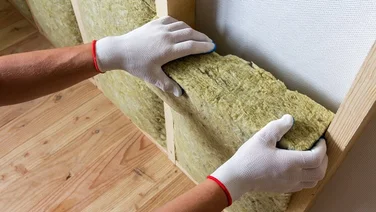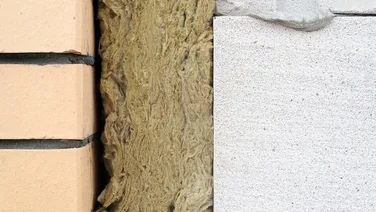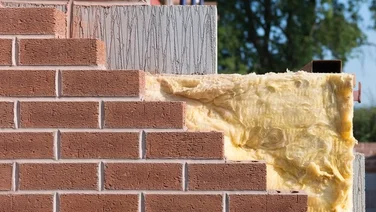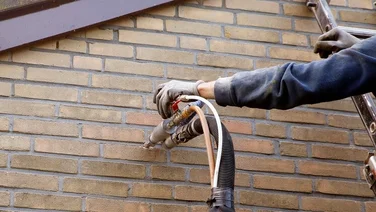- Getting spray foam insulation presents problems for homeowners
- It can damage roofs, the environment, and impact health
- While an effective insulator, it might be better to get a less damaging alternative
- Spray foam insulation can last up to 80 years with the right maintenance
Spray foam insulation comes with numerous problems, the biggest of which are:
- It’s not eco-friendly
- It can damage your roof
- It’s possibly bad for your health
- It causes bad smells
- It can create mould and mildew
It’s not particularly environmentally friendly, for example, and it can make it difficult (if not impossible) to remortgage your home (more on that later).
We’ve examined the 5 key problems with spray foam insulation and, more importantly, how to solve them.
If you’re ready to get spray foam insulation, just fill in this simple form to start. All you need to do is put in a few details about your home. We’ll connect you with our trusted suppliers, and they’ll get back to you with obligation-free quotes for you to compare.
What is spray foam insulation?
Spray foam insulation, also known as spray polyurethane foam, is a liquid insulation. You can get a professional to use spray foam to insulate your floors, loft, roof, or walls. After taking the appropriate safety measures, they’ll spray the substance – made of isocyanate and polyol resin – onto your chosen location, and it’ll expand to at least 30 times its size, forming a solid layer of insulation that looks like a cloud. Otto Bayer created polyurethane in 1937, and it quickly became a common material in all kinds of products, from car seats and baby mattresses to bungee cords. 20.5 million tonnes of polyurethane goods are now exported across the world per year, to the tune of £4.8 billion.
1. It’s not eco-friendly
Even though spray foam insulation helps homes stop wasting energy (in turn, helping the environment), you can’t escape the fact that the majority of spray foam material insulation is just not eco-friendly.
In fact, it’s overwhelmingly made from nonsustainable materials, so it’s difficult to see it as the catchall solution for insulating our homes in the long run.
Older spray foam insulation is also a petroleum-based product, and as the world moves away from fossil fuels, it will inevitably become a thing of the past. However, more modern products are more sustainable (like recycled materials) and even bio-based options as an alternative.
It isn’t just what spray foam is made from either – applying it has big environmental risks that are hard to ignore.
When you apply spray foam, you need to use a ‘blowing agent.’ These are commonly made from a mixture of hydrofluorocarbons, and therein lies the problem.
Hydrofluorocarbons have an incredibly high ‘Global Warming Potential’ (GWP). GWP is measured from a base level of 1, with carbon dioxide (CO2) from burning fuel defined as the start of the scale.
Methane (CH4) is well-known as being a good deal worse for the atmosphere than carbon dioxide. Its GWP level is 28, which means it is 28 times worse for the environment than carbon dioxide.
How bad are hydrofluorocarbons then? Really, really bad – hydrofluorocarbons have an astonishingly high GWP level of 3,400, which would make releasing just 1 kilogram of the stuff into the atmosphere the equivalent of releasing 3.4 tonnes of carbon dioxide.
It is important to note, however, that the spray foam insulation industry has been moving towards low-GWP alternatives, such as hydrofluoroolefins (HFOs), in recent years. These materials have significantly lower GWPs, often less than 1, making them more environmentally friendly.
Some older types of spray foam insulation also contain volatile organic compounds (VOCs), which can harm the environment and human health. This is primarily an issue during the application, as “set” spray foam releases very low to zero amounts.
From a recycling point of view, spray foam insulation is pretty dreadful because of how it clings to roofing materials. This makes recycling any parts of your roof (for example, during renovation or even a full roof replacement) very difficult.
250,000 UK homes have spray foam insulation.
This shows the growing popularity of this form of insulation, considering it only started to become commonly used in this country during the 1980s.
With the government encouraging homeowners to cut their emissions, we can expect spray foam to be used in many more houses over the next decade.
2. Spray foam insulation can cause roof damage
Like other types of insulation, spray foam insulation can be installed in the attic or roof, under the floors, or in the walls.
When done correctly, spray foam insulation shouldn’t cause significant damage to your roof. However, if you’ve opted for “closed-cell” spray foam in your roof, you run certain risks.
Closed-cell foam is less porous than open-cell spray foam. This means that once it dissipates into your loft, the warmth will have nowhere to go. This might not sound like a problem, but the greater warmth has a hidden danger—expansion and contraction.
When things heat up, they expand, and subsequently, when they cool down, they contract. This process of expansion and contraction can damage roofs. Expansion and contraction cause gaps to appear in key parts of your roof, which decreases their structural integrity.
After a while of this process happening again and again, the likelihood of damage occurring increases.
Additionally, spray foam insulation can increase condensation in the winter, which can cause damage to untreated timbers. Damage to timbers can directly impact the structural integrity of your roof.
While other kinds of roof insulation, like fibreglass, can also cause similar issues, most other types of insulation don’t ‘stick’ to your roof the way spray foam does, making it harder to rectify once an issue is detected. For example, you can easily remove fibreglass insulation if you want, but spray foam insulation removal is difficult and potentially damaging.
One reason spray foam insulation can make your home difficult to mortgage (or remortgage) is the potential for damaging roofs. Of the 20 largest in the UK, TSB Bank, Skipton Building Society, Co-operative Bank, Principality, and equity release lender Aviva have publicly stated they will not lend if spray foam insulation is found in the roof space.
It is important to note, however, that most mortgage lenders do not have issues with spray foam insulation if installed correctly by certified professionals.
As the BBC reported, many (around one quarter, in fact) are reluctant due to concerns over poor fitting, which can lead to moisture buildup and roof timber decay.
According to the Insulation Manufacturers Association (IMA), spray foam can be beneficial if properly installed. However, the IMA is concerned that homeowners could be needlessly driven to “cowboy” removal companies if mortgage companies refuse to provide finance because of these concerns.
The cost of closed-spray foam insulation is usually between £20–£50 per m², and £30–£70 per m² for open-cell. This is about three times more expensive than fibreglass.
To compare to other types of insulation, loose-fill insulation costs around £7.50 per m², blanket insulation will set you back roughly £5 per m², and a thermal foil layer will be about £3 per m².
Spray foam insulation will typically costing around £2,500 to £4,075 for a three-bedroom semi-detached property. That often depends on the type of spray foam and size of the wall cavity.
Spray foam is usually more expensive than other types of home insulation, partly because it’s more effective at locking in heat.
Remember, it does come with a number of potential risks that you should be aware of before purchasing. These include potentially making your home more difficult to sell, and impossible to mortgage or remortgage.
You can read how it could also affect the structural integrity of your home and impact the environment in our guide on spray foam insulation.
Spray foam insulation costs £20–£50 per square metre – though this will depend on how thick it is. To give you an idea of how much spray foam insulation will cost for your property, we’ve taken a median price of £35 per square metre, and outlined just how much homeowners would have to pay to insulate different types of properties.
Factors that affect the price include:
- Size of the property you want to insulate
- Thickness of the foam
- Type of insulating spray foam (open or closed cell)
- Amount of time it takes to install
For a clearer idea of how spray foam insulation might cost, use our table and calculator below.
| Property type | Average property size (m²)* | Average cost of 100mm-thick spray foam |
|---|---|---|
House | 97.5 | £3,412.5 |
Bungalow | 76.5 | £2,677.5 |
Flat | 41.5 | £1,452.5 |
Maisonette | 78.5 | £2,747.5 |
3. It can cause health complications
Spray foam insulation is known to cause a few health issues, including:
- Asthma
- Sensitisation
- Lung damage
- Other respiratory and breathing problems
There are chemicals found with some earlier spray foam types that contain carcinogenic properties (such as benzene), which can increase the chances of developing cancer. Some also contain toluene, which has been linked to neurological damage, and xylene, a substance that can irritate skin and eyes.
Additionally, the emissions released when applying spray foam can be damaging. We mentioned VOCs earlier, which react with chemicals in the air to form potentially dangerous compounds such as nitrogen dioxide.
This can lead to headaches and eye irritation if absorbed by someone over a long enough period. Again, however, it is important to note that most modern commercially available products must meet strict EU, UK, and US regulations, meaning they are highly unlikely to contain chemicals known to cause human health issues.d eye irritation if absorbed by someone over a long-enough period.
No. Under no circumstances should you try to install spray insulation yourself. If applied incorrectly, spray foam insulation can cause serious damage to your roof. The harmful fumes produced during installation are another reason to leave it to a professional.
4. Spray foam insulation can cause bad smells
There’s a pretty unfortunate problem associated with spray foam insulation – bad smells, or more specifically, a fishy odour that seems to hang around for months after installation.
Whilst unpleasant, the issue is rare, especially if installed correctly by professionals.
For those unlucky enough to suffer from this, the cause is usually the installer’s fault. If they’ve applied the spray foam either too thickly or too quickly, the reaction that causes the spray foam to expand properly is interrupted.
Applying it too quickly makes the exothermic reaction get too hot, meaning the next layer doesn’t react properly. When you apply it too thickly, the layer underneath cannot expand as it normally would, leaving gaps and causing the spray foam to react incorrectly again.
When the foam reacts in the wrong way, it gives off excess gas, which causes a nasty smell. Another reason for this is that the installer doesn’t use the correct mixture of chemicals.
This doesn’t automatically mean the installer is at fault because oftentimes, they just work with the chemical mix they’re given.
One more environmentally-friendly option is cellulose insulation, which is made from recycled paper and other plant-based fibres.
This option has a lower R-value than spray foam insulation, meaning it doesn’t insulate quite as well, but it is around two or three times cheaper and comes from naturally occurring materials.
Many people still rely on the classic fibreglass insulation, which is a tried-and-tested way of keeping your home warm. Another advantage is that you can install it yourself – but if you’re not sure, we’d still recommend getting a professional to do the job.
5. Mould and mildew is (sometimes) a problem
When you use closed-cell spray foam, you get a much tighter insulating seal, which keeps a lot more heat in than other forms of insulation.
The major potential downside of this is that, by keeping in so much warmth, you can create the perfect environment for mould and mildew to flourish.
Of course, mould and mildew are not guaranteed with spray foam insulation—in fact, they are more likely to appear with fibreglass and fabric insulation.
One thing to note is that there is a conflict of interest between businesses promoting spray foam insulation and businesses promoting alternatives. The former insist that spray foam insulation is great for preventing mould and mildew, and the latter usually stresses the opposite.
It is also important to note that while this is a potential problem, it can be overcome with adequate ventilation and moisture control in the impacted areas. This could include something as simple as trickle vents or more sophisticated mechanical ventilation systems.
Unfortunately, yes, and it can potentially make your property harder to mortgage.
The Royal Institute of Chartered Surveyors says that if a property is found to have spray foam insulation, they may either reduce its value, or request an independent specialist report.
A report from the BBC in November 2024 said that as much as a quarter of lenders were refusing mortgage applications because the property had spray foam insulation.
Every installation will be unique and will need assessing on a case-by-case basis. If you plan to sell your property and are thinking about getting spray foam insulation, it is worth investigating whether it will impact the sale.
Remember as well that spray foam is also a pain to remove from properties as the material will effectively glue itself to your roof. This can be an issue if you’re trying to remove it from older timber structures, and the process of doing so can cause damage.
Spray foam can sometimes increase condensation within a property too, which has the unfortunate effect of damaging things like timber structures.
Other issues to consider are:
- Installing spray foam insulation releases harmful fumes, meaning you’ll need to vacate your home for at least 24 hours.
- It can hinder ventilation, increasing the chance of condensation and damp – if you have a timber roof, you potentially run the risk of it decaying.
- It is usually not suitable for listed buildings, or for those with thatched roofs.
How can I fix spray foam insulation problems?
Simply put, the best way to avoid spray foam problems is not to install it in the first place, and instead choose superior, safer options that will cut your energy bills, such as normal loft insulation or cavity wall insulation.
Insulation is a great thing to do, and you should absolutely consider doing so as part of any effort to cut your bills and reduce carbon emissions.
For more information on what type to choose, read our insulation cost guide.
Summary
- Spray foam insulation is effective at reducing energy waste, but its traditional petroleum-based composition and high-GWP blowing agents raise environmental concerns, although modern alternatives are improving sustainability.
- Newer spray foams use low-GWP hydrofluoroolefins (HFOs) and meet stringent safety regulations, significantly reducing environmental and health risks compared to older products.
- Improper installation of spray foam, particularly closed-cell types, can lead to roof damage from expansion and contraction, increased condensation, and difficulties with repairs or mortgages.
- Health risks during installation, such as exposure to VOCs and off-gassing, can be mitigated by evacuating homes for 24 hours and ensuring professional application with modern, compliant materials.
- Bad smells caused by improper chemical reactions during application highlight the importance of hiring skilled, certified installers to avoid costly and challenging fixes.
- Proper ventilation and moisture control, along with thorough pre-installation assessments, can prevent mould, mildew, and structural issues, ensuring the long-term benefits of spray foam insulation.
Before considering installing spray foam insulation, it is important to note that the Homeowners Alliance (HOA) does not recommend installing spray foam until issues with lenders and rogue traders are resolved.
That being said, if you are considering insuring your home but are unsure about spray foam or any other product, fill out our simple webform to get an idea of which insulation will be best for your home. Enter a few short details about your home, and we’ll connect you with our expert installers.
They’ll get back to you with obligation-free quotes for you to compare.









